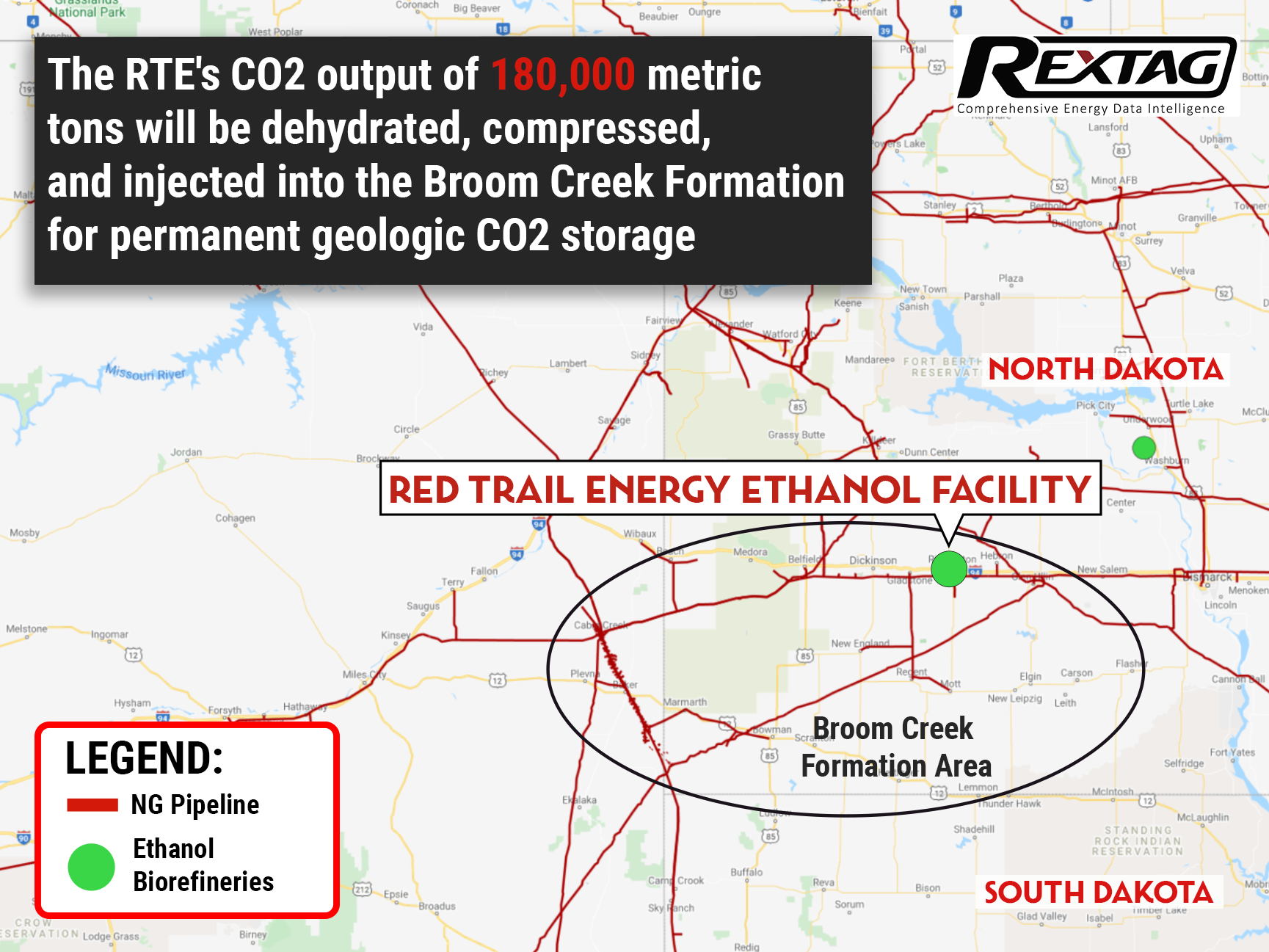Comprehensive Energy Data Intelligence
Information About Energy Companies, Their Assets, Market Deals, Industry Documents and More...
The race for landmark CCS project: North Dakota approves Class VI well for Red Trail Energy
10/27/21
Thanks to the North Dakota Industrial Commission (NDIC) blessings, Red Trail Energy LLC (RTE) is now able to commercially capture, compress, and inject 180,000 tons of carbon dioxide per year into the Broom Creek Formation on its property for permanent geologic CO2 storage.
Watchdog work at Flickertail State on geologic sequestration of CO2 is unrivaled in the country. As of 2018, North Dakota was the first state to receive primacy for Class VI wells from the United States Environmental Protection Agency (EPA), followed by Wyoming only in 2020.
And now a breakthrough was achieved: RTE may geologically store CO2 at its ethanol facility near Richardton after approval from the Department of Mineral Resources (DMR) on October 19. In addition to deciding the financial obligations, the orders confirm the creation of the required pore space for the reservoir storage required to operate the facility.
RTE's initial construction was as a coal-fired ethanol plant, but in 2016 it was converted to natural gas. On an annual basis, RTE produces 59-64 million gallons of ethanol using 21-23 million bushels of corn. The resulting fermentation process at RTE releases approximately 180,000 metric tons of high-purity CO2 every year during ethanol production. Accordingly, RTE has received approval to commercially capture (dehydrate and compress) and inject 185,000 metric tonnes of CO2 into the Broom Creek Formation on its property for permanent geologic CO2 storage.
A project developed by Red Trail in conjunction with the Energy & Environmental Research Center ensures that carbon dioxide can be stored safely for generations to come. In response to such a policy, the company's innovative and rigorous approach was commended by the watchdog for setting the standard for future carbon capture applications.
The EPA classifies wells into various categories. Geologic sequestration refers to injecting CO2 deep into rock formations for long-term storage - Class VI well is used to do this. The goal of geologic carbon sequestration is to reduce or eliminate the release of carbon dioxide into the atmosphere by storing the gas in deep geologic formations.
It is possible to capture carbon dioxide from stationary sources such as power plants and other large industrial facilities, compress it, and inject it into porous, permeable geologic layers, where it will remain relatively isolated. A layer of impermeable rock must be deposited over the geologic formation where the CO2 is stored to keep it in.
The state's geological resources were first evaluated 18 years ago, and North Dakota policymakers developed the legal and regulatory framework for geological storage 12 years ago. As North Dakota continues to develop its abundant geological resources, the approval of the RTE permits represents a major milestone.
Additionally to the permits, RTE received a $25 million loan from the USDA under the Rural Energy for American Program in September 2021 for its carbon capture and storage project (CCS). Simultaneously, a $500,000 matching grant from the NDIC was awarded to the Energy and Environment Research Center for the development of the RTE CCS project back in June.
If you are looking for more information about energy companies, their assets, and energy deals, please, contact our sales office mapping@hartenergy.com, Tel. 619-349-4970 or SCHEDULE A DEMO to learn how Rextag can help you leverage energy data for your business.
Hess Corp. Increases Drilling Activity Before Chevron Takeover
![$data['article']['post_image_alt']](https://images2.rextag.com/public/blog/232Blog_Hess Corp. Increases Bakken Production Before Chevron Deal.png)
Hess Corp. is in the final stages of a major sale to Chevron, with increased drilling and production in the Bakken region noted in the last quarter. Hess announced its fourth-quarter net production in the Bakken reached 194,000 barrels of oil equivalent per day (boe/d), a slight increase from the third quarter's 190,000 boe/d and a significant 23% rise from the 158,000 boe/d seen in the fourth quarter of the previous year. This growth is attributed to more drilling and the impact of the previous year's severe winter weather.
The Hunting Season Is Not Over Yet: Exxon Mobil makes a $400 million commitment to Wyoming's carbon capture
![$data['article']['post_image_alt']](https://images2.rextag.com/public/blog/Exxon_Mobil_carbon_capture_storage.png)
Carbon footprint reduction is a new hot trend: Exxon Mobil makes a $400 million investment into its LaBarge facility to expand its carbon capture and storage capabilities by another million metric tons of CO2. Operational activities could begin as early as 2025 after a final investment decision is made in 2022. At present, about 20% of all CO2 captured worldwide each year is captured at the LaBarge. However, as one of the largest of the world's Big Oil companies, it is not the only project in Exxon's pipeline: aside from CCS capabilities, the LaBarge is one of the world's largest sources of helium, producing approximately 20% of global supply
![$data['article']['post_image_alt']](https://images2.rextag.com/public/blog/327_Blog_Oil Market Outlook A Year of Growth but Slower Than Before.jpg)
The global oil market is full of potential but also fraught with challenges. Demand and production are climbing to impressive levels, yet prices remain surprisingly low. What’s driving these mixed signals, and what role does the U.S. play?
![$data['article']['post_image_alt']](https://images2.rextag.com/public/blog/326_Blog_USA Estimated Annual Rail CO2 Emissions 2035.jpg)
Shell overturned a landmark court order demanding it cut emissions by nearly half. Is this a victory for Big Oil or just a delay in the climate accountability movement?
![$data['article']['post_image_alt']](https://images2.rextag.com/public/blog/325_Blog_ Expand Energy's Operations (formerly Chesapeake) .jpg)
Before it was Expand Energy, the largest natural gas-weighted exploration and production company in the U.S., it was Chesapeake Energy. This company faced and survived nearly every extreme the energy industry could throw, including bankruptcy. With its recent $7.4 billion merger with Southwestern Energy, Expand Energy has achieved a new milestone: it’s the largest natural gas producer in the U.S., powered by substantial reserves and resources across crucial shale regions.